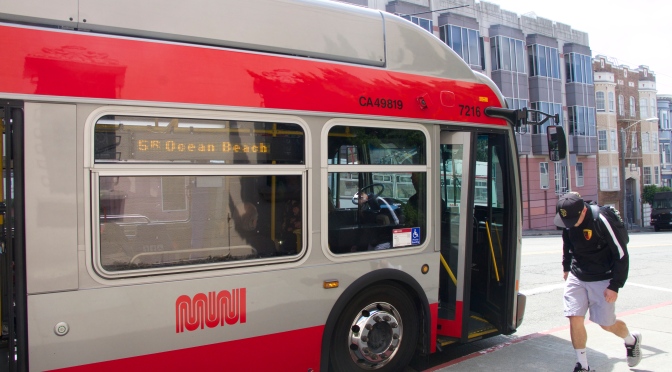Sarinya Harinsuta
Contributing Writer
Upon returning to campus, students may have noticed that the 43 Masonic line no longer makes stops on Golden Gate Avenue. San Francisco Municipal Transportation Agency (SFMTA) dubbed the removal of the stop as a “service improvement,” which will increase the reliability of the 43 line. This decision was part of a larger program known as the Muni Forward Transit Priority Project. The removal took away the bus shelter that sat on the corner of the intersection, where USF students could be seen waiting for the next scheduled arrival. According to the SFMTA website, the problems they would mainly like to address are the factors that cause so many delays, specifically traffic congestions, slow boarding times, transit stops not being well-spaced out and narrow travel lanes.
Besides the stops on Golden Gate Avenue, Joe Fitzgerald Rodriguez, a staff writer from the San Francisco Examiner, reports that the SFMTA plans to speed up its service by removing or shifting another 136 out of about 3,600 total bus stops in the city. Now students boarding the 43 Masonic will have to either walk down to Fulton Street or up to Turk Boulevard.
Freshman business administration major Nick Stefan said it was unfortunate that the stop was removed, especially since it will be a little more difficult to explore the city.
Junior advertising major Hilda A. Baltodano, has also taken issue with the removal of the 43 Masonic stop on Golden Gate Avenue, because it has made her commute to school “tremendously inconvenient.” She takes the 43 Masonic northbound from Genesee Street and Flood Avenue to USF and claims that, with the removal of the stop, getting off on either Fulton or Turk and then having to walk back to Golden Gate Avenue is more troublesome than it used to be. She believes it must be as equally inconvenient to other USF students with similar routes. Baltodano also feels that getting rid of the stop on Golden Gate Avenue is unsafe since “drivers don’t necessarily see you,” and that someone “could die crossing Turk,” she said.
Some key upgrades have also been made to the 5 Fulton Rapid line (5R). This August, SFMTA replaced some of the old 40-foot buses with the new 60-foot articulated electric trolley buses similar to that of the 38 Geary Rapid buses. According to the SFMTA website, the 5R runs about 17 percent faster than the regular 5 Fulton line. By adding new 60-foot buses to the route, it will provide bus riders 50 percent more capacity on each bus. According to Jerold Chinn from SF Bay News, this switch will be able to accommodate up to 112 additional riders. This upgrade is crucial to the 5 and 5R line, since approximately 22,000 passengers boarding the buses daily. Not only does it reduce overcrowding, the new buses also offer a more comfortable and relaxed ride across town.
As of April 23, the 28R 19th Avenue Rapid Muni bus has also undergone some changes. Seven stops have been removed, while six new locations have been added to the service. The route, which connects the Sunset and Richmond districts, is especially significant for USF students living off campus in those areas. With the revised route, it will only provide a single connection between Balboa, Park Station, SF State University, Stonestown, Parkside, the Inner Sunset and the Inner Richmond. Trips are significantly faster when compared to that of the regular 28 to 19th Avenue buses
Sophomore kinesiology major James Lew is a lifelong San Francisco resident, and said that he is more likely to use public transportation to school than get a ride from his parents. “The new improved buses really helps with finding a seat or standing space instead of being squished between other riders,” said Lew.
As for the timeliness of Muni, Lew says he tries to arrive at a stop more than a few minutes in advance just in case there is a delay. City law stipulates that Muni vehicles arrive “no more than one minute early or four minutes late.” According to Muni’s clock, a minute can last “as long as 119 seconds – or one minute and 59 seconds.” So by Muni’s definition, arriving 4 minutes 59 seconds late is still considered as being “on-time,” said John Haley, the agency’s operations chief. In this case, Lew would miss his scheduled 5 Fulton bus that would take him up to school, and therefore making him late for work at Koret. This would still go down in the books as an on-time arrival because of the unusual definition of the SFMTA.
For the time being, freshman students seem to be taking advantage of the convenience that the Uber or Lyft apps provide, especially in a big city where rideshare wait times tend to stay low. Freshman business administration major Jack Farricker said that he uses Uber more frequently than Muni, especially because he considers the price for rides to be more than reasonable. “Muni’s not that bad, but so many kids Uber nowadays, and if I know I only have to pay nine or even four dollars to get to downtown, I’ll definitely take Uber,” said Farricker. Freshman biology major Jillian Aluning said she’s exclusively using Uber and walking to go from place to place, saying she first wants to get her bearings around campus before exploring the rest of the city through public transport.
On the other hand, junior advertising major Asma Alsaadi says she trusts public transportation so much that she doesn’t even have the Uber or Lyft apps installed on her phone; her daily commute includes a BART ride into the city from MacArthur Station.
As a reminder to all freshman, dorms provide bus schedules on the screens near the elevators. Apps like Routesy, MuniWatch, Next Bus and Swiftly are among the most commonly used transportation apps. If in the near future you lose your student identification card along with the Muni bus pass (therefore losing your one and only bus pass for the semester), Muni recently released their official app, Muni Mobile, which allows you to purchase your bus ticket using your credit card or PayPal.











 Nichole Rosanova is a senior media studies major.
Nichole Rosanova is a senior media studies major.



 Jose Esquer-Romero is a freshman business administration major.
Jose Esquer-Romero is a freshman business administration major.
















